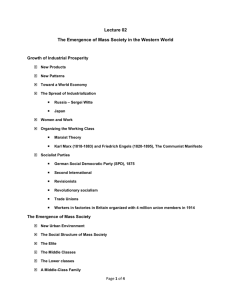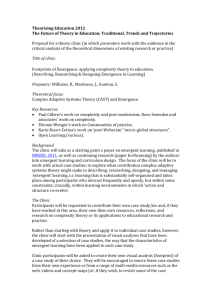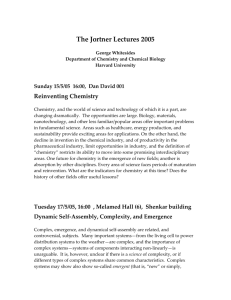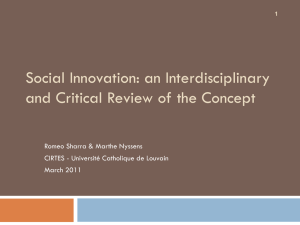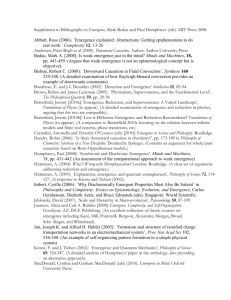Encyclopedia of Philosophy article on Emergence
advertisement
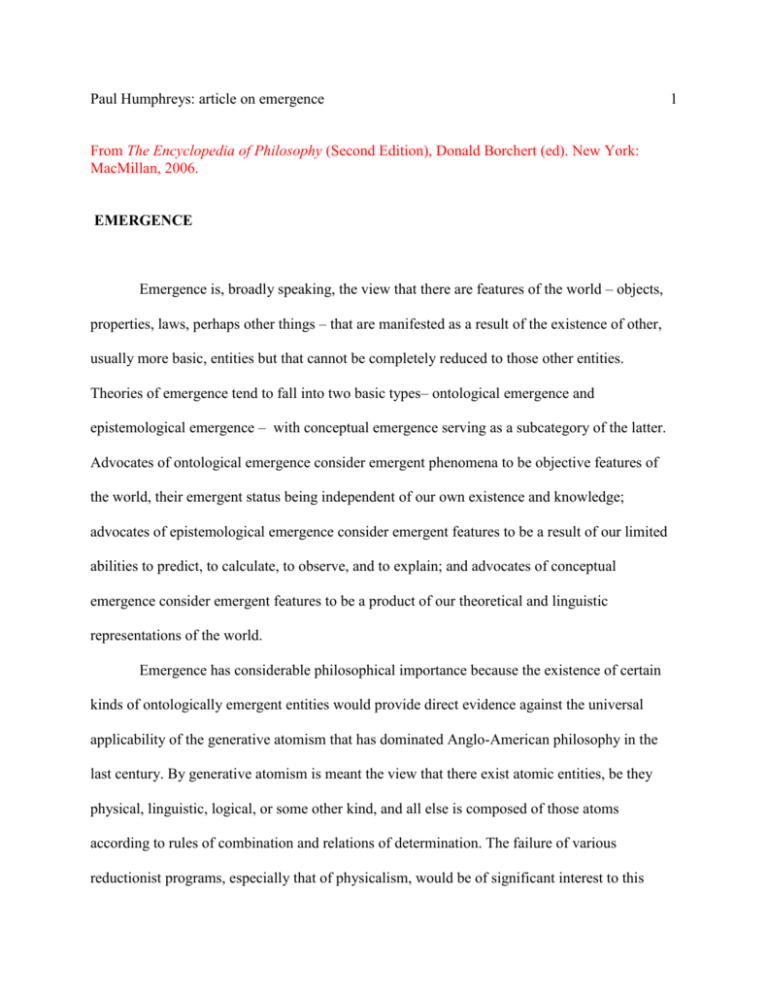
Paul Humphreys: article on emergence From The Encyclopedia of Philosophy (Second Edition), Donald Borchert (ed). New York: MacMillan, 2006. EMERGENCE Emergence is, broadly speaking, the view that there are features of the world – objects, properties, laws, perhaps other things – that are manifested as a result of the existence of other, usually more basic, entities but that cannot be completely reduced to those other entities. Theories of emergence tend to fall into two basic types– ontological emergence and epistemological emergence – with conceptual emergence serving as a subcategory of the latter. Advocates of ontological emergence consider emergent phenomena to be objective features of the world, their emergent status being independent of our own existence and knowledge; advocates of epistemological emergence consider emergent features to be a result of our limited abilities to predict, to calculate, to observe, and to explain; and advocates of conceptual emergence consider emergent features to be a product of our theoretical and linguistic representations of the world. Emergence has considerable philosophical importance because the existence of certain kinds of ontologically emergent entities would provide direct evidence against the universal applicability of the generative atomism that has dominated Anglo-American philosophy in the last century. By generative atomism is meant the view that there exist atomic entities, be they physical, linguistic, logical, or some other kind, and all else is composed of those atoms according to rules of combination and relations of determination. The failure of various reductionist programs, especially that of physicalism, would be of significant interest to this 1 Paul Humphreys: article on emergence 2 program. In addition, the various accounts of epistemological emergence pose difficulties for the long established Cartesian requirement of completely transparent access to evidential relations. Although there is no consensus upon what counts as an emergent entity a cluster of features tends to recur in philosophical accounts of emergence. Emergent phenomena are irreducible, they are novel, they are usually unpredictable on the basis of theory, they are often unexplainable, they frequently involve global rather than merely local properties, and an emergent entity must emerge from something. This last feature separates emergent features from those entities whose existence does not depend upon anything else, such as the objects of fundamental physics or certain abstract entities. It also allows for two distinct kinds of emergence; static or synchronic emergence within which the emergent entities exist simultaneously with the entities from which they emerge, and dynamic or diachronic emergence, within which the emergent entities temporally develop from antecedent entities. Although it is rarely stated explicitly, dynamic emergence is generally held to result from more than causal processes alone. At one time, life and chemical compounds were considered to be good candidates for emergent features, covered by what John Stuart Mill in his A System of Logic , Book III, Chapter VI, §§1,2 termed heteropathic laws, but with advances in molecular biology and an understanding of the chemical bond that view fell into disfavor. Perhaps as a consequence, emergence came to be viewed with a certain degree of suspicion, apparently requiring a commitment to occult qualities that was at odds with the analytic methods of science and philosophy. It is thus ironic that emergence has re-emerged as a vigorous and lively field of Paul Humphreys: article on emergence 3 investigation, has shed much of its air of mystery, and plausible candidates for emergent phenomena have been discovered in fundamental areas of physics as well as in other areas of science such as complexity theory. As a result, it is important when considering emergence not to restrict one’s range of examples to the widely discussed cases of mental properties. This article will emphasize contemporary positions on emergence, although occasional historical references will be made to illustrate conceptual continuities For a history of the area, the reader is referred to Brian McLaughlin’s 1992 survey article. Ontological Approaches to Emergence. An influential ontological approach to emergence uses supervenience relations to account for emergent features. An early version of this approach by James van Cleve (1990) asserted that a property P of a system is emergent if and only if P supervenes with nomological necessity but not with logical necessity on properties of parts of the system, and some of the supervenience principles linking the basal properties with P are fundamental laws. That is, once the features of the most fundamental level are fixed so, via laws of nature, are the features of all higher levels. Advocates of supervenience approaches, especially the widely canvassed position known as humean supervenience, generally hold that supervenience is all that is required to account for higher-level features of the world. David Lewis provided an influential statement of this position in the second volume of his Philosophical Papers (1986), pp.ix-xvi. Supervenience approaches usually contain the irreducibility and novelty aspects of emergence. Whether the global, unpredictability, and unexplainability features are present depends upon the type of supervenience involved. A different ontological position, developed by Jaegwon Kim in his article `Making Sense Paul Humphreys: article on emergence 4 of Emergence’ (1999), begins with the idea that a higher level property P is reducible if (a) P can be functionalized i.e. defined in terms of its causal role (b) realizers of P can be found at a lower level, and (c) there is a lower level theory that explains how the realizers operate. In contrast a property is emergent if it is neither a physical property nor reducible to physical properties in the sense just described. Kim’s position retains the irreducibility, novelty, theoretical unpredictability, and unexplainability features of emergent phenomena but apparently has the consequence that there is little scope for their existence, except perhaps in the case of qualia or consciousness. The novelty of emergent features is usually captured in the idea that an emergent entity E must be qualitatively different from the entities from which it emerges. A popular version of this idea asserts that a property P is emergent if it has novel causal powers not possessed by entities at lower levels. The causation involved can be horizontal (to entities at the same level), upwards (to a higher level), or downwards (to a lower level). When downwards causation is involved, one of the most difficult problems facing advocates of supervenience emergence and many other ontological accounts of emergence occurs. This is the problem of causal exclusion, of explaining how emergent features can influence lower levels via downwards causation if one subscribes to the causal closure of lower levels as, for example, do most physicalists. For if the lower level is casually closed, any downwards influence is redundant, unless causal overdetermination is allowed. A clear statement of this argument can be found in Kim’s 1992 article `”Downward Causation”in Emergentism and Nonreductive Physicalism’. A third ontological approach to emergence, found in Paul Humphreys’ 1997 article `How Paul Humphreys: article on emergence 5 Properties Emerge’, addresses this problem. It has as its core idea the view that in certain cases of dynamic emergence the original elements or their properties fuse together in a way that the identities of those elements are lost in forming the new emergent entity. This feature allows emergent phenomena to avoid the causal exclusion argument because the lower level entities no longer exist and a fortiori cannot be causal competitors to the emergent entity. The position entails the irreducibility, novelty, and holistic features of emergent phenomena, but allows their predictability and explainability. Certain holistic quantum systems possessing states of joint systems but not states of individual components seem to be examples of fusion. Epistemological Approaches to Emergence Turning to epistemological accounts of emergence, one of the oldest approaches emphasizes the essential unpredictability of emergent phenomena. It is sometimes loosely and unhelpfully characterized in psychological terms by noting that emergent phenomena are surprising. A more precise version asserts that a property P belonging to domain E is emergent relative to a domain D, where E is at a higher level than D, if it is impossible to predict the occurrence of instances of P on the basis of any ideal theory about D. Early accounts of emergence based on unpredictability can be found in Stephen Pepper’s article `Emergence’(1926) and C.D.Broad’s book The Mind and Its Place in Nature (1925). This unpredictability approach conforms to Ernest Nagel’s well-known approach to the reduction of one theory to another in Chapter 11 of his The Structure of Science (1961). Within Nagel’s account, one theory is irreducible to another if the laws of a higher level theory cannot be deduced from those of a more fundamental theory by employing bridge laws connecting the two Paul Humphreys: article on emergence 6 levels. Thus, in a somewhat crude manner the essential unpredictability approach to emergence captures the idea that if biology is Nagel-irreducible to physics then biological phenomena are emergent from physical phenomena. It satisfies the novelty, irreducibility and, trivially, unpredictability aspects of emergence and also accommodates nomological emergence, the view that entities of type B are emergent from entities of type A if and only if entities of type B have type A entities as constituents and there is at least one law that applies to type B entities that does not apply to type A entities. A statement of nomological emergence can be found in the physicist P.W. Anderson’s much cited 1972 article `More is Different’. A diachronic version of the unpredictability approach to emergence is widely used within the field of complexity theory and rests on the idea of stable patterns spontaneously emerging in a system. Although these patterns are, simply in virtue of being patterns, non-local, they are not the result of a central organizing principle but result from local, often non-linear, interactions between members of a population. Examples of pattern emergence abound in what are commonly termed self-organized systems, one simple example of which is the formation and maintenance of bird flocks. The general area of agent-based or individual-based models, which include many examples of self-organizing systems, is of interest to philosophy because it combines a bottom up commitment to individualism with the dynamic emergence of higher level structures possessing the features of novelty and holism. Such models can illuminate the traditional philosophical issue of methodological individualism, an issue which divides those who hold the view that there are sui generis facts in the social sciences from the individualists who deny this. Paul Humphreys: article on emergence 7 Because the dynamic emergence of the patterns can often be modeled only via computer simulations, an important aspect of these systems is captured by Mark Bedau’s concept of weak emergence. A weakly emergent property P is one possessed by a structured system S, where P is incapable of being possessed by components of S, and S’s possessing P is a fact that can be derived only by a step by step simulation of S. Despite its connection with prediction via computer simulations, weak emergence is ultimately a metaphysical rather than an epistemological account of emergence. The structure of the system places objective constraints on the possibilities of computation and complex physical and biological systems must step through their own development, thus making weak emergence a claim about the world itself. A particularly interesting kind of weak emergence occurs when a pattern P exists independently of the nature of the specific components of the system exhibiting the pattern so that the structure is in that sense autonomous. There are connections here with the multiple realizability of higher level properties, a topic which has played an important role in arguments against reduction. One approach to emergence that explicitly considers multiple realizability is Robert Batterman’s asymptotic emergence. This sort of emergence involves a relation between two theories, one of which is a limiting case of the other and it is unusual in not relying on the part/whole relationship upon which most other theories of emergence are based. Conceptual Approaches to Emergence Running parallel with the issues of epistemological and ontological emergence is the phenomenon of conceptual emergence, based upon the idea that theories employed at different levels of the hierarchy employ different concepts and that these concepts require the introduction Paul Humphreys: article on emergence 8 of distinctive, irreducible, predicates and relations. This approach is captured in Paul Teller’s characterization: An emergent property of a whole is one which is not explicitly definable in terms of the non-relational properties of the object’s proper parts. Because definability depends upon the linguistic resources available in a given language or theory, this criterion for emergence is relative to the theory or language employed and reflects a common feature of linguistic development. If psychological and sociological features, to take two examples, are ontologically emergent, we should expect the resources of explicit definability to fail us and to force the invention of new vocabulary. It is not difficult to see how each of the approaches to emergence described above can necessitate this kind of linguistic innovation and it calls into question various enterprises of linguistic reduction. Although it is not couched in terms of emergence, the influential arguments found in Jerry Fodor’s 1974 article `Special Sciences’ against reduction and in favor of the autonomy of the special sciences can be construed as reasons in support of conceptual emergence. Other Issues In contemporary philosophy, a commitment to emergent entities is generally held to violate physicalism, the position that our world’s ontology contains nothing but the ontology provided by physics. What `nothing but’ means differs from one version of physicalism to another, as does what is included within the scope of physics, but the core idea is that anything not required by fundamental physics is in principle redundant, even though we may employ a Paul Humphreys: article on emergence 9 non-physicalist vocabulary for practical reasons. Thus, mental entities such as beliefs are mere façons de parler on the physicalist view, and the social sciences have no genuine subject matter of their own. Strict versions of physicalism maintain similar views about biological and chemical entities. All three approaches to emergence – ontological, epistemological, and conceptual – tend to appeal, implicitly or explicitly, to a layered view of the world that is divided into levels, with features at higher levels emerging from those at lower levels. This appeal to levels is usually grounded in the idea that larger entities such as molecules spatially include as parts smaller constituents such as atoms, this inclusion relation resulting in the familiar hierarchy of elementary particle physics, solid state physics, chemistry, biochemistry, biology, neurophysiology, and so on. Although this levels picture serves as a natural image within synchronic emergence, it can be a seriously misleading metaphor for diachronic emergence. There is much casual talk in the literature on emergence about the difference between aggregate features and emergent features, the latter, in contrast to the former, being more than `mere sums’ of the features of their components. It has turned out not to be informative to try to precisely capture what constitutes a `mere sum’ but traditionally, holism – summed up in the slogan that the whole is greater than the sum of the parts – remains a core part of what is wanted from emergent phenomena. It is preferable to replace `greater than’ by `different’ and if this is done we have the suggestion that a property P is emergent only if it is a property of an entire system S that is composed of sub-systems S1,...,Sn but none of the Si possess P. This feature is possessed by, at least, the fusion, asymptotic, weak, and nomological approaches to emergence. The principal aim of any philosophical account of emergence should be to make Paul Humphreys: article on emergence 10 emergence intelligible and non-trivial. It is a separate matter, one with which science is properly concerned, whether the universe contains any examples of emergence. It is, nevertheless, a matter of considerable interest to philosophy whether examples of ontologically emergent phenomena exist because, if they do, our universe is more than an ontologically modest combinatorial device. See also: REDUCTION, SUPERVENIENCE. References Anderson, P.W. `More is Different’, Science 177 (1972), pp. 393-396. Batterman, Robert. The Devil in the Details: Asymptotic Reasoning in Explanation, Reduction, and Emergence. New York: Oxford University Press, 2002. Beckerman, Ansgar, Hans Flohr, and Jaegwon Kim (eds). Emergence or Reduction?: Essays on the Prospects of Nonreductive Physicalism. Berlin: Walter de Gruyter, 1992. Bedau, Mark . `Downward causation and autonomy in weak emergence’, Principia Revista Internacional de Epistemologica 6 (2003), pp. 5-50. Bedau, Mark and Paul Humphreys: Emergence: Contemporary Readings in Science and Philosophy. Cambridge: The MIT Press, 2006. Broad, C.D. The Mind and Its Place in Nature. London: Routledge and Kegan Paul, 1925. Fodor, Jerry. `Special Sciences, or The Disunity of Science as a Working Hypothesis’. Synthese 28 (1974), pp. 97-115. Paul Humphreys: article on emergence Holland, John. Emergence: From Chaos to Order. Reading, Mass.: Addison-Wesley, 1998. Humphreys, Paul. `How Properties Emerge’, Philosophy of Science 64 (1997), pp. 1-17. Kim, Jaegwon. `”Downward Causation” in Emergentism and Nonreductive Physicalism’ pp. 119-138 in Beckerman et al. (1992). Kim, Jaegwon. `Making Sense of Emergence’ Philosophical Studies 95 (1999), pp.3-36. Lewis, David. Philosophical Papers, Volume II. Oxford: Oxford University Press, 1986. McLaughlin, Brian, `The Rise and Fall of British Emergentism’, pp. 49-93 in Beckerman et al. (1992). Mill, J.S. A System of Logic: Ratiocinative and Inductive. London: Longmans, Green and Company, 1843. Nagel, Ernest. The Structure of Science. New York: Harcourt, 1961. Pepper, Stephen. `Emergence’ Journal of Philosophy 23 (1926), pp. 241-245. Teller, Paul. `A Contemporary Look at Emergence’ pp.139-153 in Beckermann et al. (1992). van Cleve, James. `Mind-Dust or Magic? Panpsychism versus Emergentism’, Philosophical Perspectives 4 (1990), pp. 215-226. Paul Humphreys Word Count 2577 11
